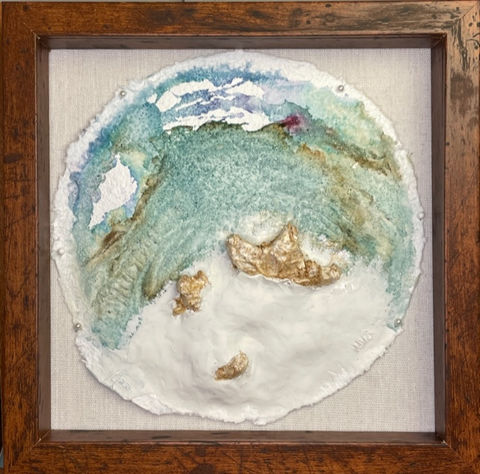UpClose: Blooming Earth
2024

Acting as both an exploratorium and a herbarium, “Up Close: Blooming Earth” brings us intimately close to the Greening, a term by the Christian mystic, Hildegard of Bingen, Germany. The body of work contains 21 paintings which are each framed in a 10x10x1 inch shadow box frame. Each piece comes with its own handheld magnifying glass. The handheld allowed visitors and owners of each painting to look closely and see how mycelium grows together in layers. Like early explorers, you will find that each painting highlights the use of mycelium as a medium. Mycelium is the soil-like substrate that fruits mushrooms, also known as the “Wood Wide Web.” Through the mycelial network, messages are sent thtrough the mycelium living under, inside and all around trees and all plant life. This substrate shares 50% of our DNA. (Merlin Sheldrake, Entangled Life) This invites you to learn more about the natural treasures found deep within our earth. Butterflies, fungi, bees, frogs, hummingbirds, and dragonflies addition to species of mushrooms such as orange mycena, basket stinkhorns, and even an underwater, gilled mushroom found in 2005 in Crater Lake, Oregon titled Psathyrella Aquatica, all rely on mycelium and its information provided by tree networks and plants alike.
The exhibition is an Earth inspired, botanical wonder highlighting the use of foraged materials, botanical painting methods, and mycelium as a medium. The mycelium used in select pieces is unseeded, meaning it will never fruit mushrooms. Each piece has been oxidized at 200 degrees, which removes any remaining natural anomalies and cures the pieces into one whole fired object. The goal of this body of work is to bring awareness to the delicacy of our planet and its natural wonders. Through the use of healthier materials for a healthier world, we battle a term coined by Jane Goodall: Eco-Grief. This is my way of inspiring future generations of stewards working on the behalf of the natural world. I also host workshops informing participants how they can participate in an effort to continue to heal the Earth through the use of natural materials. When we begin to Green our lives we heal ourselves and the Earth. My work is biodegrade, leaving behind no trace if left in the ground. If kept in a controlled environment the works will last a lifetime.
As a resident of Bloomington, Indiana, I find living close to nature inspires my work and provides direct access to ethical foraging. I am sharing this project with our community to bring the natural world to friends, families, and visitors from our community up close to our beautiful Blooming Earth. For the past 3 years I have participated in Yale Universities program for teaching artists, curators and other professionals. The Teacher Leadership Program is a free, one-hour workshop on Zoom for educators of all levels and disciplines that meets at 4:00 pm on the first Thursday of the month throughout the academic year. The sessions are led by Jessica Sack, the Jan and Frederick Mayer Curator of Public Education; Wurtele Gallery Teachers; and Education Department staff. In this program, educators explore innovative ways to connect their curricula and interest in art with the Yale University Art Gallery’s collection. The sessions also address online and in-person teaching techniques. Inquiry-based science is a teaching approach that I have learned about throught this program. It encourages students to explore scientific concepts through hands-on investigations, questions, and critical thinking. In addition, libraries around the world have served as allies in my search to discover High Middle Age botanical recipes. I spent countless hours in the Lilly Library. Their collection of illuminated manuscripts is outstanding and contains a stunning 17, 000 manuscripts and over 21, 000 rare books. Indiana University’s Lilly Library is a state, national and international treasure, and a testament to the vision and generosity of J.K. Lilly Jr.
Many of us wonderers and citizen scientists, have found new ideas are found in questioning everything around us and exploring a new terrain of thoughts on the past that have found new life in the present.
John Waldron Arts Center, Educational Gallery, 9, 2024.
Gallery
The use of mycelium in each of the works is stable. If you leave the paintings in controlled environments
like a gallery, museum or a home the color and mycelium will remain stable. If you take the piece out of the frame and put the painting into the ground it will biodegrade. This is sustainable work that is plant based, living works on recycled watercolor paper. The mycelium I use is from Ecovoative. Color recipes are stabled and were learned through a variety of natural color workshops as well as research with the Lilly Library with Indiana University in Bloomington, Indiana. The final step is to fire each piece at 200 degrees for one hour to ensure each piece as been oxidized and will not fruit mushrooms. In addition, it's never a good idea to put artwork directly in sunlight.
























